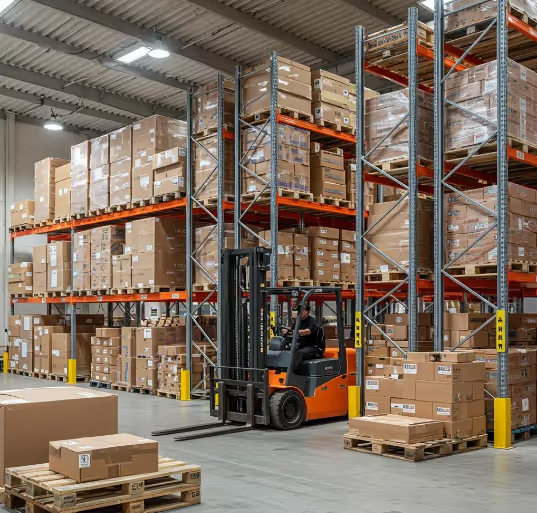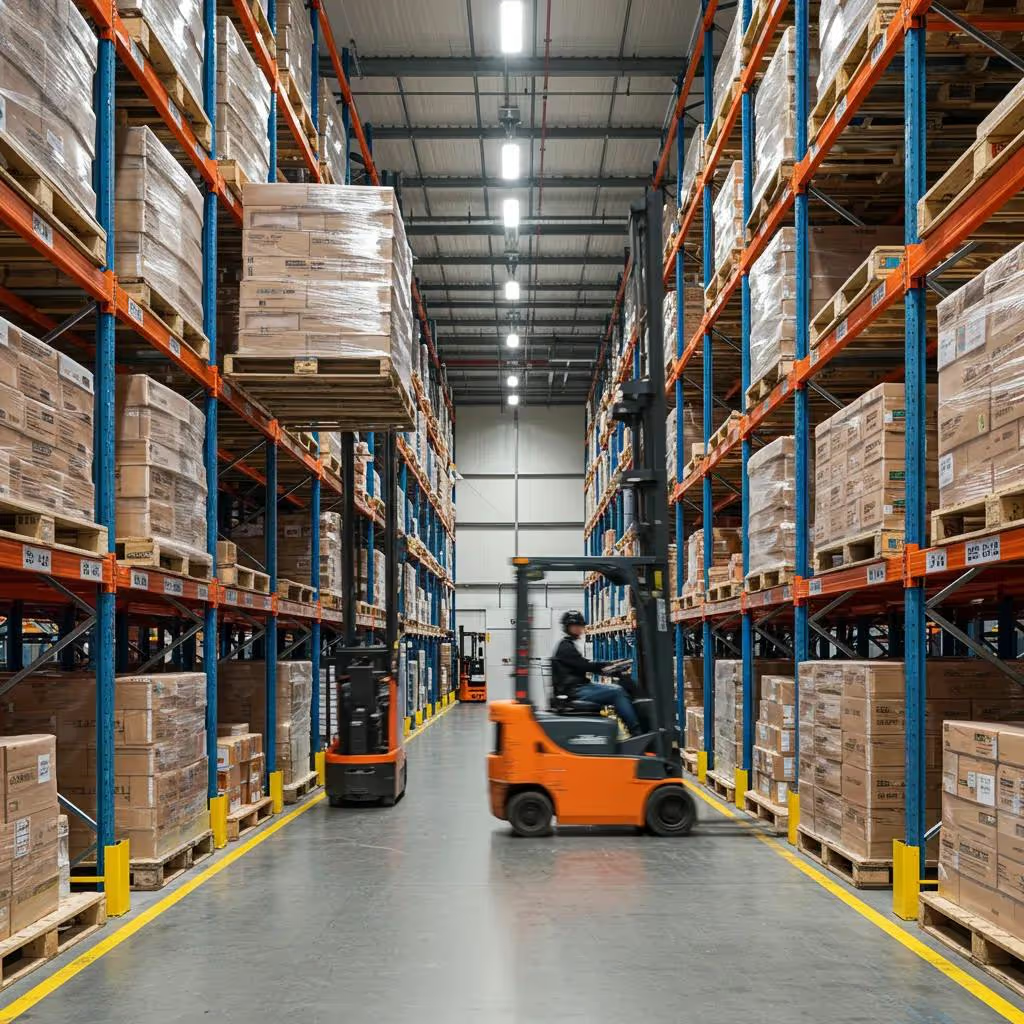
Efficient warehouse storage hinges on choosing the right pallet racking system to balance accessibility, density, and cost. In this guide, we define pallet racking, explore its core components and inventory benefits, and then dive into seven proven racking configurations like Selective, Drive-In/Drive-Through, Push-Back, Pallet Flow, Cantilever, Double-Deep, and Specialised systems. You'll learn installation essentials, safety best practices, forklift compatibility, cost versus ROI considerations, and how automation integration enhances overall efficiency. By the end, you'll have a clear roadmap for selecting the ideal pallet racking type to suit your warehouse's throughput, space constraints, and SKU variety.
What Is Pallet Racking and Why Is It Essential for Warehouse Storage?
Pallet racking is a modular steel framework that stores palletised goods in horizontal rows with multiple vertical levels, improving space utilisation and order fulfillment speed. Its structure supports forklifts in placing and retrieving pallets safely at height, reducing congestion and manual handling injuries. As a foundational component of modern logistics, pallet racking systems adapt to diverse load capacities, from lightweight cartons to heavy machinery, enabling businesses to scale storage without expanding square footage.
What Are the Key Components of Pallet Racking Systems?
A typical pallet racking system comprises three primary elements:
- Upright frames that bear vertical loads and define rack height.
- Horizontal beams that support pallet weight and form load-bearing levels.
- Footplates or baseplates that anchor frames to the floor for stability.
Each component's material grade, gauge, and connection style determine load capacity and seismic compliance, ensuring safe, long-term performance.
What Is Selective Pallet Racking and Why Is It the Most Common Type?

Selective pallet racking offers direct, 100 percent access to every pallet position, making it the go-to solution for warehouses handling a broad product mix. Its simple beam-and-frame assembly adapts to aisle widths that accommodate standard forklifts, balancing cost-effectiveness with operational flexibility. For general-purpose storage and fast-moving SKUs, selective racking excels in versatility and ease of rearrangement.
Advantages and Disadvantages of Selective Pallet Racking
Selective pallet racking provides unmatched accessibility and rapid SKU changeover with minimal capital outlay. However, maintaining wide aisles for forklift clearance reduces overall storage density compared to high-density alternatives.
This paper examines various dynamic storage systems, highlighting their role in managing FIFO/LIFO principles and enhancing warehouse efficiency.
Dynamic Storage Systems: Optimising FIFO/LIFO and Warehouse Efficiency
This paper examines various dynamic storage systems, such as selective racks, push-back racks, and drive-in/drive-through racks. It elucidates the distinct advantages these systems provide for managing First-In, First-Out (FIFO) and Last-In, First-Out (LIFO) principles. The authors note that these systems enhance inventory tracking and employee safety, thereby contributing to overall warehouse operational efficiency. Furthermore, the document underscores the significance of selecting appropriate storage systems to optimise space utilisation and effective inventory management, aligning with the objective of efficient warehouse storage solutions.

Selective racking's balance of cost and functionality makes it a warehouse manager's foundational storage choice, preparing the facility for potential high-density upgrades.
Industries Benefiting from Selective Pallet Racking
Industries handling a wide variety of SKUs such as retail distribution, general manufacturing, and automotive parts suppliers that leverage selective racking to manage frequent pick cycles. E-commerce fulfillment centers favor its adaptability to seasonal product shifts, while pharmaceutical warehouses rely on its direct FIFO compatibility for batch control and regulatory compliance.
Installation and Maintenance of Selective Pallet Racking
Installing selective racking begins with surveying floor loads and planning rack bay locations, followed by anchoring upright frames to prepared concrete and locking beams into place. Routine maintenance includes torqueing beam connectors, inspecting welds, and verifying rack plumb and alignment. Certified installation teams ensure correct anchor spacing and provide inspection checklists to uphold safety standards over the system's lifespan.
How Do Drive-In and Drive-Through Racking Systems Maximise High-Density Storage?

Drive-In and Drive-Through racking systems boost warehouse density by stacking pallets on rails, allowing forklifts to enter rack lanes and ideal for bulk storage of similar products. Drive-In uses a single entry/exit point (LIFO), while Drive-Through provides two-sided access (FIFO), balancing density gains with inventory rotation requirements. Both systems reduce aisle count by up to 60 percent, reclaiming valuable floor space for additional racks or work areas.
Differences Between Drive-In and Drive-Through Racking
Drive-In racking stores pallets in a back-to-back design where the last pallet placed is the first retrieved (LIFO), suited for non-perishable bulk loads. Drive-Through racking aligns lanes front-to-front, permitting FIFO rotation, which benefits perishable or date-sensitive goods.
This paper delves into the design principles of drive-in and drive-through racking, emphasizing their high-density storage capabilities and adaptability for FIFO or LIFO inventory management.
Design Principles of Drive-In and Drive-Through Racking Systems
This paper elucidates the design principles and practical applications of drive-in and drive-through racking systems. These systems are particularly advantageous for warehouses requiring high-density storage of homogenous products, thereby optimising space utilisation. The document details the operational mechanisms of these racks, with a primary focus on the "First-In, First-Out" (FIFO) principle and its adaptations. It also addresses the "Last-In, First-Out" (LIFO) principle and how distinct rack configurations can accommodate either FIFO or LIFO inventory management methodologies. The authors emphasize the advantages conferred by these systems for achieving efficient inventory flow and effective space management.

Choosing between these systems depends on product shelf life and access frequency, informing inventory management strategies.
Safety Considerations for Drive-In Racking
Safety in drive-in lanes depends on reinforced guide rails, adequate clearances, and trained forklift operators. Guardrails and column protectors prevent impact damage to uprights, while lane markings direct safe vehicle entry. Regular inspections of rails and beams detect wear or misalignment before it compromises rack integrity.
Warehouses Ideal for Drive-In and Drive-Through Systems
Facilities storing bulk quantities of single-SKU products such as cold storage warehouses, beverage distribution centers, and paper roll storage, benefit from space-saving drive-in configurations. Drive-Through systems suit food distribution or chemical warehouses where expirations necessitate FIFO rotation without sacrificing density.
What Are the Benefits of Push-Back Pallet Racking for Multiple SKUs?
Push-Back racking uses nested carts on inclined rails to store 2–6 pallets deep, offering high density while preserving relatively quick access for multiple SKUs. As new pallets enter from the front, existing pallets push back on the cart mechanism; when retrieving, carts roll forward by gravity. This configuration increases storage capacity by up to 75 percent compared to selective racks while supporting mixed product lines.
How Push-Back Racking Works with Carts and Inclined Rails
Push-Back systems mount galvanised rails at a slight incline, allowing loaded carts to roll toward the back of the bay under gravity. When a forklift places a new pallet, it pushes the entire row of carts back one position. During retrieval, the front pallet is removed and the next pallet rolls forward automatically. This mechanism streamlines deep-lane replenishment without manual repositioning.
Maintenance of Push-Back Racking Systems
Maintaining push-back racking involves lubricating wheel bearings on carts, ensuring rail surfaces remain free of debris, and inspecting spring-loaded stops that regulate cart movement. Periodic checks of cart alignment and rail wear preserve smooth operation and prevent skewing or pallet damage.
Inventory Management Methods Supported by Push-Back
Push-Back racking inherently operates on a LIFO basis due to its back-to-front cart design, making it ideal for cold storage or bulk finished goods. For operations requiring FIFO rotation, complementary flow-through systems may be installed alongside or in adjoining bays to handle perishable or lot-tracked items.
How Does Pallet Flow Racking Enhance FIFO Inventory Management?
Pallet Flow racking employs gravity-driven roller or wheel tracks mounted on a slightly inclined chassis, enabling pallets to roll from loading to pick faces under controlled speed. This design guarantees FIFO rotation as pallets loaded first reach the picking aisle first, combining high storage density with automated stock rotation that is important for food, beverage, and pharmaceutical distribution.
Key Features of Gravity Roller Systems in Pallet Flow Racking
Gravity roller systems consist of steel rollers or plastic wheels spaced to support pallet bases, with flow lanes angled typically at 2–4 percent gradient. Brake assemblies regulate pallet speed to prevent collisions, while entry and exit guides ensure smooth alignment. Frame end stops secure pallets at the picking face, maintaining order and safety.
Industries Benefiting from Pallet Flow Racking
Perishable-goods sectors such as cold chain logistics, dairy distribution, and produce wholesalers that rely on pallet flow for strict FIFO compliance. Beverage bottlers and pharmaceutical warehouses also leverage this system to preserve product integrity and meet rotation requirements without manual interventions.
How Pallet Flow Racking Improves Warehouse Throughput
By automating pallet conveyance within the racking bay, pallet flow racking reduces forklift travel distances by up to 75 percent, accelerating replenishment and picking cycles. The continuous first-in, first-out flow minimises staging steps and frees operators to focus on value-added tasks rather than internal transport.
What Are the Uses and Design Features of Cantilever Racking for Bulky Items?
Cantilever racking is a steel arm-supported system that stores long, unwieldy items such as lumber, pipes, and sheet metal by removing upright obstructions at the front. Single- or double-sided cantilever arms extend horizontally from vertical columns, allowing easy loading with forklifts or cranes. Its open-face design accommodates awkward lengths and shapes without intermediate beams.
Differences Between Single-Sided and Double-Sided Cantilever Racking
Single-sided cantilever racking mounts arms on one side of the column, ideal against walls or perimeter locations, while double-sided systems provide access from both sides, maximising aisle-to-aisle storage. Double-sided units double load positions per column line but require clear aisles on each side for handling.
Types of Goods Best Stored on Cantilever Racking
Long goods that lack palletisation such as steel tubing, timber planks, vinyl rolls, and PVC conduit that fit seamlessly on cantilever arms. Fabricators, lumberyards, and pipe distributors exploit its versatility to store varying lengths in dedicated zones, improving pick accuracy and reducing material damage.
Safety and Load Considerations for Cantilever Systems
Load capacity hinges on arm length, column height, and base support; overloading can cause arm deflection or column bending. Proper anchoring and bracing safeguard against tipping, while predetermined arm spacing prevents stack instability. Regular inspections verify weld integrity and fastener torque to maintain safety compliance.
How Does Double-Deep Pallet Racking Increase Storage Density Compared to Selective Racking?
Double-Deep racking positions two pallets back-to-back on each level, cutting required aisle space by half and boosting storage density by up to 50 percent over selective racks. While direct access to the second pallet requires specialised deep-reach or articulated forklifts, the trade-off between space savings and equipment investment often yields strong ROI for high-volume SKUs.
Specialised Forklifts Needed for Double-Deep Racking
Double-Deep configurations rely on reach trucks with extended-reach or articulated mast designs capable of extending through the first pallet to retrieve the second. Operators require training on load stability at maximum extension, and battery capacity must support extended hydraulics to maintain cycle efficiency.
Pros and Cons of Double-Deep Racking
- Pros: Up to 50 percent density gain, lower rack investment per pallet position
- Cons: LIFO or mixed-use limitations, specialized equipment requirement
Maximising Warehouse Space with Double-Deep Racking
Combining double-deep lanes with selective aisles in a hybrid layout balances high-density storage for slow-moving stock and accessible positions for fast movers. A slotting analysis to identify candidates for double-deep storage and to optimize rack bay lengths for your forklift fleet's capabilities is recommended.
What Are Other Specialised Pallet Racking Systems and Their Warehouse Applications?
Beyond core configurations, advanced systems like Very Narrow Aisle (VNA), Mobile, Carton Flow, and Multi-Tier racking address unique space and throughput demands. These specialized solutions integrate robotics, automated picking carts, and elevated work platforms, extending storage capacity both horizontally and vertically while maintaining rapid access.
Benefits of Very Narrow Aisle (VNA) Racking
Very Narrow Aisle racking uses aisles as narrow as 1.2 meters, doubling pallet positions per square meter compared to conventional aisles. High-precision VNA forklifts or turret trucks navigate these aisles via wire guidance or laser navigation, offering substantial footprint savings in high-rent facilities.
How Mobile Racking Improves Warehouse Space Efficiency
Mobile racking mounts entire rack rows on motorised or manual carriages that shift to open a single active aisle. By eliminating permanent aisles, mobile systems reclaim up to 70 percent of floor area, making them ideal for cold storage, archives, or compliance goods with lower pick frequencies.
What Is Carton Flow Racking and How Does It Support Order Picking?
Carton flow (or flow-through) racking uses roller tracks for small cartons or totes, enabling first-in, first-out rotation at the pick face. It accelerates piece-pick operations by presenting cartons at ergonomic heights and reducing travel time between pick slots, driving up order-picking rates.
This paper investigates strategies for mitigating inventory issues through efficient racking systems designed to promote FIFO methodology, evaluating various methods and their advantages.
Efficient Racking Systems for First-In, First-Out (FIFO) Inventory Management in Warehousing
Contemporary warehousing operations frequently encounter space storage challenges, primarily attributable to slow-moving, obsolete, or excessive inventory. A common issue arises when products initially stored in a warehouse become buried beneath subsequently received items. Over time, the upper layers of inventory are dispatched, leaving the lower layers to accumulate dust, leading to obsolescence, expiration, or damage. This 'first-come, last-served' scenario is a direct consequence of inadequate inventory management policies. This paper investigates strategies for mitigating such inventory issues through the implementation of efficient racking systems designed to promote the First-In, First-Out (FIFO) methodology. The study involves an evaluation of various racking methods and designs, each presenting distinct advantages and disadvantages. Effective implementation of FIFO necessitates the selection of the most suitable method from these available options.
How Multi-Tier Racking Expands Vertical Storage Capacity
Multi-Tier racking integrates walk-in work platforms or mezzanine levels above pallet bays, creating additional picking or storage floors. It multiplies usable square footage by building vertically, offering cost-effective expansion without new construction and supporting high-density carton or tote storage.
How Do Warehouse Storage Solutions Integrate Pallet Racking with Forklifts and Automation?
Modern warehouses pair racking systems with the right forklift types and automation technologies like robotic pallet shuttles, automated guided vehicles (AGVs), and IoT sensors to boost throughput and reduce labor costs. Integration ensures seamless material flow from receipt to dispatch, with data-driven rack slotting and real-time monitoring optimising space and cycle times.
Which Forklift Types Are Compatible with Different Pallet Racking Systems?
Standard counterbalance forklifts suit selective and cantilever racks, while reach trucks handle single-deep selective and double-deep racks. Turret trucks or VNA forklifts navigate narrow aisles for high-density systems, and specialised articulated trucks serve drive-in and pallet flow applications, ensuring safe engagement and load handling.
How Warehouse Automation Enhances Pallet Racking Efficiency
Automation solutions such as robotic pallet shuttles in drive-in lanes, AS/RS cranes for high-bay racking, and vision-guided picking robots, minimise human intervention in repetitive tasks. IoT-enabled load sensors and weight scales embedded in racks provide real-time inventory data, enabling predictive replenishment and preventive maintenance scheduling.
Safety Standards and Best Practices Ensuring Compliance in Pallet Racking
Industry standards, including RMI and EN 15635 guidelines, mandate regular rack inspections, anchor torque checks, and load-label verification. Best practices involve clear signage of weight capacities, collision-resistant barriers, safety netting for loose goods, and operator certification programs to uphold workplace safety and regulatory compliance.
How Do Cost and ROI Compare Across Different Pallet Racking Types?
Evaluating installation, maintenance, and equipment costs against storage density gains and labor savings reveals each racking type's return on investment. While selective racking demands lower upfront capital, high-density or automated systems like flow racks and mobile carriages deliver greater ROI in space-limited or high-throughput operations.
Installation and Maintenance Costs for Each Racking System
Installation costs vary by complexity:
- Selective racking: lowest labor and anchor requirements.
- Drive-In/Drive-Through: moderate rail welding and guide installation.
- Pallet Flow/Carton Flow: additional brake assemblies and roller tracks.
- Mobile racking: highest due to carriage motors and control panels.
Storage Density Impact on Return on Investment
Higher storage density reduces real estate and energy costs per pallet position. For example, mobile racking can reclaim floor space worth thousands per square meter, while pallet flow reduces forklift travel which translates into labor savings of up to 30 percent annually, accelerating payback periods.
Factors Warehouse Managers Should Consider When Choosing Racking
Key criteria include SKU turnover rates, product characteristics, facility footprint, capital budget, forklift fleet compatibility, and future scalability. A thorough slotting analysis and space utilisation study guide the selection process, ensuring the chosen pallet racking system aligns with business growth and operational goals.
Choosing the right pallet racking type transforms warehouse performance by aligning storage density, accessibility, and cost. Expert consultation and professional installation services ensure each system meets safety standards and integrates seamlessly with automation and inventory software. By applying the principles in this guide, from defining core racking components to evaluating ROI, you can tailor your storage solution to current demands and future expansion. Begin optimising your warehouse today with a holistic pallet racking strategy that delivers measurable efficiency and long-term savings.


.svg)






